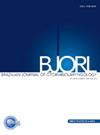Brazilian Society of Otology task force – single sided deafness – recommendations based on strength of evidence
IF 1.7
4区 医学
Q2 OTORHINOLARYNGOLOGY
引用次数: 0
Abstract
Objective
To make evidence-based recommendations for the treatment of Single-Sided Deafness (SSD) in children and adults.
Methods
Task force members were instructed on knowledge synthesis methods, including electronic database search, review and selection of relevant citations, and critical appraisal of selected studies. Articles written in English or Portuguese on SSD were eligible for inclusion. The American College of Physicians’ guideline grading system and the American Thyroid Association’s guideline criteria were used for critical appraisal of evidence and recommendations for therapeutic interventions.
Results
The topics were divided into 3 parts: (1) Impact of SSD in children; (2) Impact of SSD in adults; and (3) SSD in patients with temporal bone tumors.
Conclusions
Decision-making for patients with SSD is complex and multifactorial. The lack of consensus on the quality of outcomes and on which measurement tools to use hinders a proper comparison of different treatment options. Contralateral routing of signal hearing aids and bone conduction devices can alleviate the head shadow effect and improve sound awareness and signal-to-noise ratio in the affected ear. However, they cannot restore binaural hearing. Cochlear implants can restore binaural hearing, producing significant improvements in speech perception, spatial localization of sound, tinnitus control, and overall quality of life. However, cochlear implantation is not recommended in cases of cochlear nerve deficiency, a relatively common cause of congenital SSD.
巴西耳科学会特别工作组--单侧耳聋--基于证据强度的建议。
目的:为儿童和成人单侧耳聋(SSD)的治疗提供循证建议:为儿童和成人单侧耳聋(SSD)的治疗提供循证建议:向工作组成员传授知识综合方法,包括电子数据库搜索、审查和选择相关引文,以及对所选研究进行批判性评估。以英语或葡萄牙语撰写的有关 SSD 的文章均符合纳入条件。美国内科医师学会的指南分级系统和美国甲状腺协会的指南标准被用于对证据和治疗干预建议进行批判性评估:主题分为三部分:(1) SSD 对儿童的影响;(2) SSD 对成人的影响;(3) SSD 对颞骨肿瘤患者的影响:对 SSD 患者的决策是复杂和多因素的。结论:SSD 患者的决策是复杂和多因素的,在结果质量和使用何种测量工具方面缺乏共识,这阻碍了对不同治疗方案进行适当的比较。信号助听器和骨传导设备的对侧路由可以减轻头影效应,改善患耳的声音意识和信噪比。但是,它们无法恢复双耳听力。人工耳蜗可以恢复双耳听力,显著改善言语感知、声音空间定位、耳鸣控制和整体生活质量。但是,对于耳蜗神经缺失的病例,我们不建议进行人工耳蜗植入,因为这是先天性 SSD 的一个相对常见的原因。
本文章由计算机程序翻译,如有差异,请以英文原文为准。
求助全文
约1分钟内获得全文
求助全文
来源期刊

Brazilian Journal of Otorhinolaryngology
OTORHINOLARYNGOLOGY-
CiteScore
3.00
自引率
0.00%
发文量
205
审稿时长
4-8 weeks
期刊介绍:
Brazilian Journal of Otorhinolaryngology publishes original contributions in otolaryngology and the associated areas (cranio-maxillo-facial surgery and phoniatrics). The aim of this journal is the national and international divulgation of the scientific production interesting to the otolaryngology, as well as the discussion, in editorials, of subjects of scientific, academic and professional relevance.
The Brazilian Journal of Otorhinolaryngology is born from the Revista Brasileira de Otorrinolaringologia, of which it is the English version, created and indexed by MEDLINE in 2005. It is the official scientific publication of the Brazilian Association of Otolaryngology and Cervicofacial Surgery. Its abbreviated title is Braz J Otorhinolaryngol., which should be used in bibliographies, footnotes and bibliographical references and strips.
 求助内容:
求助内容: 应助结果提醒方式:
应助结果提醒方式:


